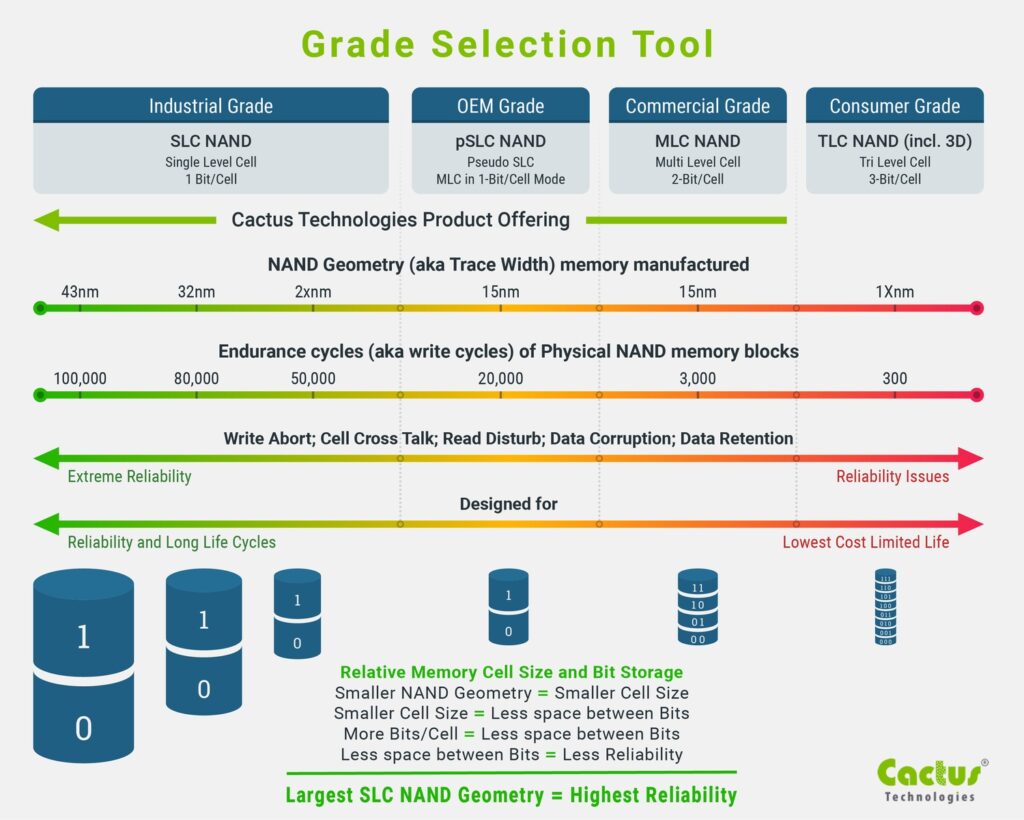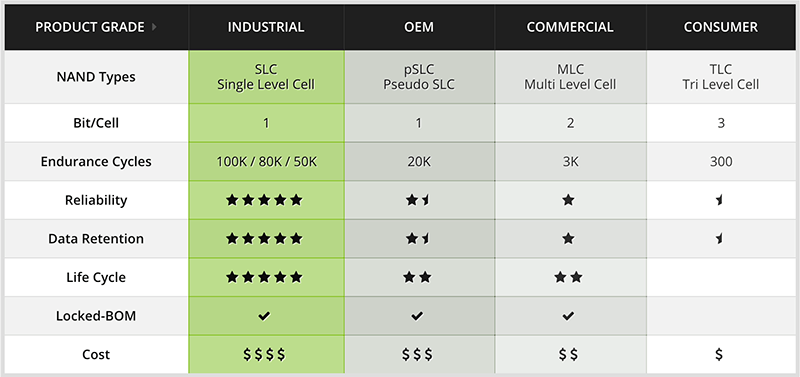What are Industrial, Industrial pSLC & Industrial MLC Flash Storage Devices and which solution is Right for my OEM System?

Industrial Grade, Industrial MLC and Industrial pSLC are terms for flash storage that have been thrown around for more than a decade. But, every day, it seems like someone is trying to redefine what these terms mean.
From a high level, here are the definitions of these three grades of flash storage products. All three are used in Embedded OEM Systems and applications but choosing the wrong part can lead to unforeseen failures.
The Three Flash Storage Grades for OEM Systems:
INDUSTRIAL GRADE – Most Reliable, based on SLC NAND, High Endurance & Data Retention.
Industrial pSLC – Reliability at a Lower Cost, based on pSLC NAND, Medium Endurance & Data Retention.
Industrial MLC – Lower Cost, based on MLC NAND, Lower Endurance & Retention, but much better than Consumer products on market.
I’ll have an in depth chart later on what each of these grades represents so you, the OEM System designer, can decide what your type of application should use.
First, Key Characteristics of Manufacturer & Supplier:
- LOCKED-BOM – Why go through all the trouble testing a flash storage device for your OEM Systems when production units you receive will be different? This is what happens with most manufacturers of flash storage. They change the internal memory or controller silicon regularly and are constantly changing the firmware. A Locked BOM (Bill-Of-Material) signifies there is no change in the components and firmware the parts are built from without customer notification. As the next bullet points out, how long this Locked-BOM stays in place is equally important.
- LONG LIFE CYCLES – Consumer flash cards and SSD are constantly changing. The only thing guaranteed is that there is a certain form factor [Ex: 2.5” SATA SSD] and capacity point [Ex: 128GB]. What goes on inside the card or SSD packaging can be anything. For OEM Systems, it is an important consideration to make sure there is first a Locked-BOM and that this Locked-BOM is available for a long time. This long time is signified by Long Life Cycles. As an example, Cactus’ Industrial Grade products, can have a 5 – 10 year life from launch to end of life with no changes to the product.
- EXTENDED LIFE CYCLES – A true supplier should have the ability to continue delivering the same Locked-BOM product for months to years after the End Of Life of a particular memory and controller configuration. Obviously there needs to be a commitment on the side of the OEM purchasing these parts. Through bonding material against a specific customer demand, a quality supplier can extend the product life by months to years.
What Grade is Right for your OEM Application?

As you can see by the chart above, it is important you define exactly what your application will require from the flash storage device. In this way, you can determine what is needed to create your OEM System with an SSD that’s good over the system’s expected life.
If you are an OEM system designer and would like more information on this or any other items related to flash storage in your design, please reach out to us for assistance.
Final Thoughts:
Cactus Technologies focus is to make the most reliable Industrial Grade Flash Storage Devices based on SLC NAND memory, with a locked-BOM (Bill-Of-Material) to ensure the performance and reliability characteristics never change over the many years of production.
We also offer alternative Industrial pSLC and Industrial MLCproducts to meet budget constrained applications. In addition, Cactus offers other interfaces to meet needs of embedded OEM application designers everywhere.
If you need assistance with an OEM design or needing special features, please contact us.






